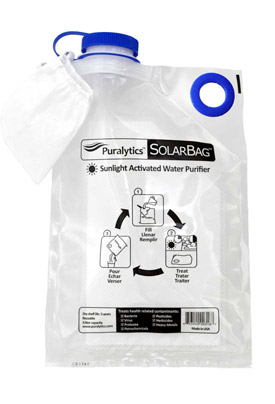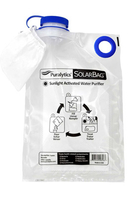SolarBag: Portable Nanotechnology Water Treatment.
$29.95 SPECIAL SALE PRICE!
DRINK FEARLESSLY: LEAD UNTREATED BY FILTERS & CARTRIDGES APPEARING IN CITY WATER SUPPLIES AND OLDER HOME PIPES NATION WIDE!
“The SolarBag is the only water purifier that’s proven it can remove virtually every lethal toxin found in contaminated water, including gasoline, diesel fuel, pesticides, herbicides, toxic heavy metals like lead, arsenic, cadmium, and mercury, and pharmaceuticals like artificial hormones and animal antibiotics.”
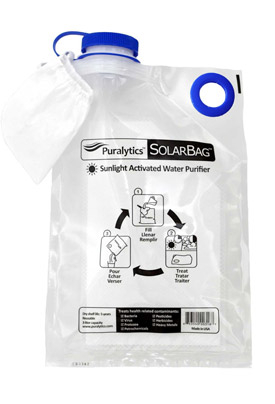
Pure Water for the Planet
Puralytics has developed a patented photochemical water purification process using only light energy either from LEDs or sunlight to activate an advanced nanotechnology coated mesh. Water is purified through simultaneous photochemical reactions, sterilizing bacteria, viruses, and other pathogens. There are no chemical additives and 100% of the water is purified.
Puralytics® products, SolarBag sets new standards for sustainability, ease of use and cost effectiveness.
Destroying Contaminants with Light
“Photocatalysis, the core patented technology”
ADVANCED NANOTECHNOLOGY
Sunlight activates a nanotechnology-coated mesh inside the SolarBag that purifies water on a molecular level, breaking down contaminants into elements and basic molecules like water and carbon dioxide. The mesh destroys organic contaminants and eliminates pathogens rather than merely trapping and concentrating them. Heavy metals are also removed.
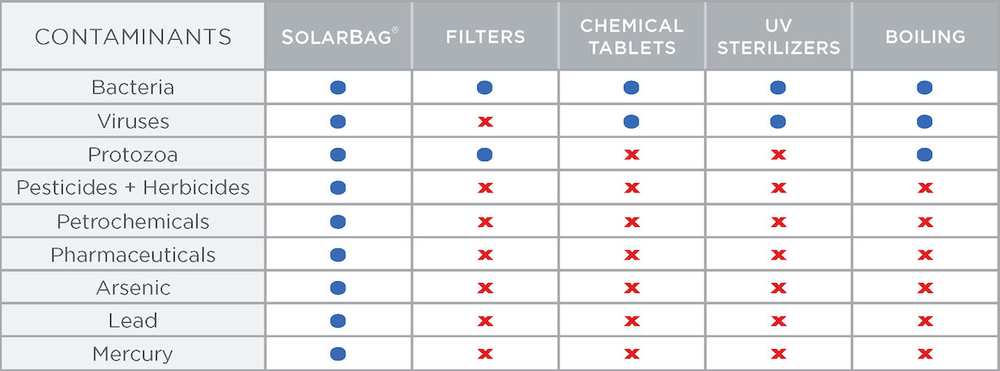
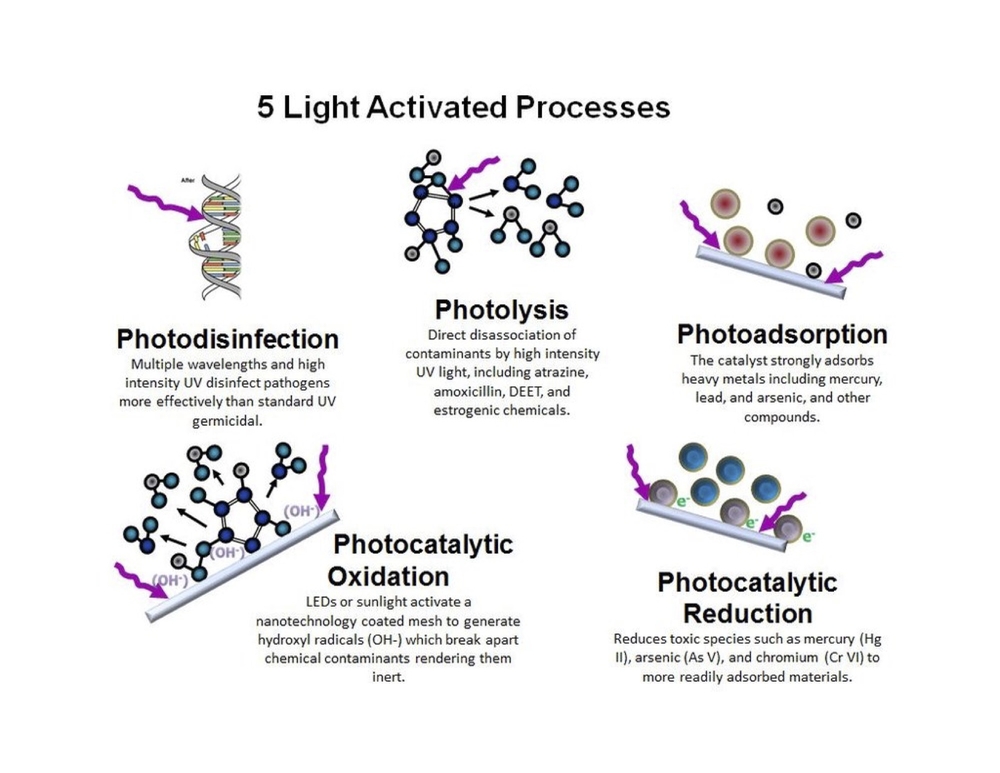
The SolarBag requires no batteries or electricity and uses no additional chemicals during the purification process. One SolarBag can treat up to 10.5 liters per day, has no replaceable parts, and is reusable hundreds of times.
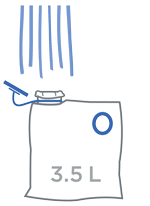
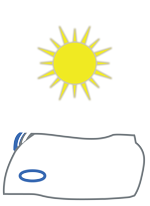
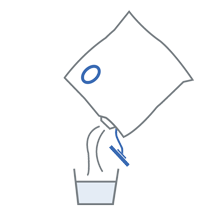
PRODUCT DESCRIPTION
The SolarBag is a re-usable portable water purifier that cleans 3.5 liters at a time.
Through solar-activated nanotechnology, the SolarBag offers the broadest contaminant removal of any portable water purifier, removing bacteria, viruses, protozoa, cysts, chemicals and heavy metals.
HOW IT WORKS:
1. FILL
Fill a SolarBag with 3.5 liters of fresh water from any source through its included pre-filter. Then place the SolarBag in direct sunlight or in any area open to the sky.
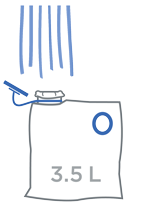
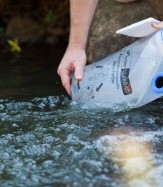
2. PURIFY
The water is purified in 2-3 hours on a sunny day or 4-6 hours on a cloudy day or if the source water is tea-colored. An indicator tells you when the water is ready.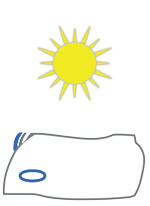
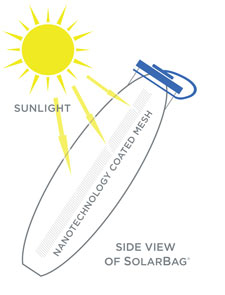
3. DRINK
Drink the safe, purified water. With simple instructions and no moving parts, a SolarBag is one of the most versatile water purifiers available. the safe, purified water. With simple instructions and no moving parts, a SolarBag is one of the most versatile water purifiers available
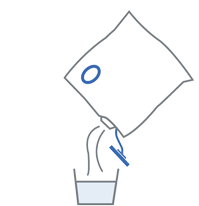
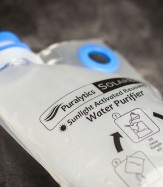
A NEW WAY TO PURIFY WATER
- Nanotechnology-based water purifier destroys contaminants instead of merely trapping them
- Activated directly by the sun, no electricity or chemicals required
- No pumping, sucking or backflushing
- Self-cleaning mesh doesn’t clog
- Produces clean tasting
MAXIMUM PROTECTION
- Exceeds highest water quality testing standards from WHO and the EPA
- Eliminates Bacteria 99.9999%, Virus 99.99%, Protozoa 99.9%
- Removes heavy metals
- Destroys manmade
ENVIRONMENTALLY FRIENDLY
- Reusable 100s of times
- Fully recyclable, BPA-free bag
- Ultra-lightweight (4 oz / 105 g)
- No waste water or by-products
Puralytics is recognized as an industry leader in water
purification technology.
- 2017 Plug and Play Tech Center New
Materials
- 2015 Backpackers Gear Test - Great
Concept Award
- 2014 BlueTech Research
Disrupt-o-meter Award, Most Innovative and Disruptive Water Technology
- 2014 USTechH2.O Exemplary US Water
Technology
- 2013 International Water
Association Global Honour Award for Drinking Water Supply
- 2013 Innovation in Sustainability
Award
- 2013 BlueTech Innovation Tracker
Award
- 2012 Inc Magazine Top 8 Best Water
Investment
- 2012 5 Star GIIRS Rating from
BLabs
- 2011 Cleantech National Investor
Conference "Most Fundable"
- 2011 Global Cleantech 100
- 2011 Zino Green Fund, Best
Cleantech Investment
- 2011 The Artemis Project, named a
Top 50 Water Technology Company
- 2011 TechCrunch Award finalist in
the Cleantech category
- 2010 ImagineH2O finalist twice for
both water and energy efficiency
- 2010 National Grandprize in the
Cleantech Open, Best Cleantech Business
- 2010 Global Water Intelligence,
Water Investment Idol
SOLARBAG®
FREQUENTLY ASKED QUESTIONS (FAQ)
1. What is the SolarBag?
The SolarBag is a sunlight-activated reusable water purifier
that destroys or removes the broadest range of contaminants without pumping,
power source, chemicals or replaceable components. Simply place the
SolarBag in the sun for a few hours, and enjoy treated water.
2. What plastic is the bag and
lid made from?
The water
contact surfaces of the bag and lid are all polyethylene.
3. Has the SolarBag been tested for
plastic migration from the bag?
We have no
test results on plastic migration from the bag into the water being treated,
but we did select the water contact materials in the bag to avoid this problem.
The water contact surfaces of the bag and lid are certified by our vendor to
have passed FDA, USP Class VI and cytotoxicity testing and are BPA free.
4. What makes the SolarBag better
than other products?
No other product available on the market will reduce as many
contaminants, metals and pathogens as the SolarBag, nor will it be as simple to
use.
5. How much water can I purify
in a SolarBag? Can it be reused?
The SolarBag treats up to 3 liters of water at a time,
several times per day and can be reused hundreds of times.
6. How does the SolarBag purify
water?
Inside the SolarBag is a nanotechnology coated mesh insert,
which is activated by the UV rays of the sun. This initiates a
purification process which includes five separate photochemical actions
addressing more contaminants than any other portable water treatment
product.
· Chemicals
are broken down to harmless minerals
· Metals are
removed from the water and sequestered by the insert
· Pathogens
are killed and rendered harmless
The full solar spectrum also contributes to disinfection of
the pathogens.
7. Explain how photocatalysis works.
Under the appropriate wavelength of light, our catalyst
becomes excited and generates an electron hole pair that can participate in
redox reactions. The result of these redox reactions are oxidation
compounds that will degrade organic compounds and microbiological matter.
The reaction is very similar to how chlorine works but there are no chemicals
that need to be added or any disinfection byproducts produced. The
oxidation compounds produced during photocatalysis are much stronger than
chlorine and result in carbon dioxide and water.
8. How does the SolarBag remove
metals from the water?
Transition and heavy metals are subject to adsorption,
photo-oxidation and photo-reduction reactions in the SolarBag. Reactions
will proceed based on the metal and the water quality. In many
situations, metals such as mercury, lead, and arsenic can be reduced in
concentration.
9. How is the mesh insert
affected my metals build up?
Adsorption
of a metal can eventually saturate the mesh’s ability to remove that metal from
water. If that happens, the performance of the mesh in removing organic
contaminants or even other metals may improve or degrade, depending on the
specific chemical composition of the water. In emergency use, the
SolarBag will improve water quality for a sufficient time to allow assessment
of water quality and address acute high concentrations of specific contaminants
that may require additional treatment modalities.
10. How long does it take the SolarBag to purify
the water?
The Puralytics® SolarBag requires only sunlight to treat
water. Treatment is fastest with intense sunlight and is further accelerated
with increasing water temperature. Sunny days in tropical latitudes are
ideal. In higher latitudes or with murky water or with overcast skies,
water treatment takes longer. We recommend performing the Pur-Blue
Integrity Test outlined on the next page to determine treatment time.
Water is treated when the blue color is gone.
On a clear, warm, sunny day the SolarBag will destroy
harmful microbes and chemicals in 2-3 hours. As conditions become cloudy
and cool, the energy from the sun is reduced and the time required for
purification can take closer to 4-6 hours.
11. What kind of water can I put in the SolarBag?
Water from any fresh water source is suitable for the
SolarBag. This typically includes rain water, well water, lake water, and river
water. For best results, the water should be clear and without color.
12. Will the SolarBag remove salts, chloride or
fluoride from the water?
No. The SolarBag is not a desalination system. Fill
the SolarBag from fresh water sources only. Monovalent monatomic anions
(like chloride or fluoride) will not be removed in a SolarBag.
13. Has the shelf life been tested?
Puralytics’
shelf life rating was determined based on the materials used in its fabrication
which are commonly used materials that have been tested by the individual
material suppliers.
14. How does the shelf life change once you
start using it?
The life for
a bag in use can extensive if it is handled properly. The end of bag life
will be after the 7 years or after several hundred uses. After a SolarBag
has been used, to prepare it for storage, the following steps should be taken:
(1) After the last intended use, stand the bag up above a reasonably clean
surface with the opening down and the lid off so that the remaining water can
drain and air can circulate to aid the drying process. Do not excessively squeeze
or shake the bag as this can damage the catalyst; (2) When most of the water
seems to be gone, turn the bag over to let any remaining water evaporate up and
out the opening. (3) After all remaining water is gone close the lid completely
and store the bag in a dark location at moderate temperature. (4) For best
results when using the bag again start with a cleaning cycle: fill it with the
cleanest available water and put it in the sun for a full day before putting
the bag back into use.
15. How long does the nanotechnology mesh insert
last?
The nanotechnology coated insert is not consumed when the
SolarBag is used; it merely serves as a catalyst converting the solar energy to
activate the purification processes. Do not fold or crush the SolarBag
during use or storage to prevent damage to the insert. With proper
handling, the SolarBag should last hundreds of cycles.
16. What do I do with the water after it has been
purified?
Once the water has been purified, use it or pour it into a
clean container for drinking or storage. Replace the cap to keep the
SolarBag clean.
17. Does the SolarBag have any kind of
certification?
The SolarBag has been tested to the US EPA Guide
Standard and Protocol for Testing Microbiological Water Purifiers for
inactivation of bacteria, viruses and protozoan cysts in a challenge water
defined by the EPA. Under these testing procedures, the SolarBag killed
more than 99.9999% of all bacteria, 99.99% of all viruses and 99.9% of all
protozoan cysts. It has also been certified or approved for use by
several foreign countries.
18. How do I know when the SolarBag is done
purifying the water? When is the water ready?
We recommend 3 hours in direct sunlight and 6 hours on a
cloudy day. You can test the performance of your SolarBag by performing a
simple test using the food safe Pur-Blue Process Timer. Simply add one
drop of the Pur-Blue to the SolarBag after you have filled it with water, then
place the SolarBag in the sun as normal. When the blue water dims in
color to almost clear, the water has been treated.
In tea-colored water, determining when then blue is gone is
more difficult. Treat for at least 3 hours with the label down. Then turn the
bag over and inspect for color. If the blue or any brown color is gone the
water is treated. If not, continue for an hour (with the label facing up). If
the blue or brown color has faded treatment is complete. If not, continue
treatment until the blue or brown color has faded.
19. How do I know if the SolarBag is still
working? How do I know when it is no longer working?
Perform the Pur-Blue test (see number 19 above) to determine
if the SolarBag is still working. The color will not degrade in the
SolarBag in sunlight if it is no longer functioning properly. If the blue
color does not go away after a full day of sunlight exposure on a sunny day,
repeat the test for a second time for confirmation.
20. Do you have to use the Pur-Blue every time to
check the water has been purified?
The Pur-Blue is a visual indicator to how well the SolarBag is
performing based on changes in the sun exposure, number of bag uses, and water
quality. Using Pur-Blue will slightly extend the treatment time for the
bag but can be used every time. Periodic checks with the Pur-Blue are
recommended in lieu of every sample batch.
21. Why is a pre-filter attached to the SolarBag?
It is important to use. The pre-filter removes larger
particles like grains of sand, leaves, and sediment from the water as its being
poured into the SolarBag. Tests have shown the pre-filter removes
particulates, as small as 100 microns. Despite this relatively large size it
also helps remove parasites like cryptosporidium.
22. How do I use the attached pre-filter?
Remove the cap and insert the pre-filter into the
SolarBag. Stretch and fold the elastic to secure it around the opening to
the SolarBag. Pour the source water through the pre-filter until the bag
is full. Remove the pre-filter and replace the cap.
23. How do I clean the pre-filter?
The pre-filter can be gently washed by hand or you can
routinely rinse the pre-filter as needed by folding it inside out and pouring
filtered water back through it.
24. Does the pre-filter have any kind of
certification?
The simple answer: The pre-filter was tested as part
of the SolarBag to the US EPA Guide Standard and Protocol for Testing
Microbiological Water Purifiers for inactivation of bacteria, viruses
and protozoan cysts in a challenge water defined by the EPA.
The technical answer: The performance of the
pre-filter was quantified in the US EPA Guide Standard and Protocol for
Testing Microbiological Water Purifiers at the University of Arizona
which showed that the pre-filter alone reduced cryptosporidium oocysts by more
than 1.5-log in both general (low NTU) and EPA challenge waters (greater than
30 NTU). The residual microbes were always killed in the SolarBag
following filtration to the necessary EPA requirements for water purifiers
(more than 99.9999% of all bacteria, 99.99% of all viruses and 99.9% of all
protozoan cysts) in all test cases.
25. How does the pre-filter compare to the mesh
insert?
The
pre-filter removes larger particles (>100 micrometers) but allows dissolved
species to pass through. The mesh insert treats the dissolved species in
the water (through photoadsorption, photooxidation, photoreduction, photolysis
and photodisinfection) but is not intended to act as a filter.
26. What is the pre-filter made from?
The pre-filter is a Pellon fabric, and acts as a particle
filter, with a nominal 100 micrometer pore size rating. It is intended to
keep out debris such as gravel, sticks and hair.
27. Can I use really turbid water in the
SolarBag?
As a general guideline, turbid water should not be used in a
SoalrBag and another water source should be used. If another water source
is not available, pour the turbid water into a separate container and allow the
suspended solids to settle before pouring only the top, clear portion of the
the water into the SolarBag.
28. Why is the water still tea-colored after
being treated in the SolarBag?
The simple answer: The SolarBag does not make all
tea-colored water clear. The tea-color typically results from two
sources, either dissolved organics or suspended solids from natural
sources. Any of the suspended solids that get passed the pre-filter will
not completely clear in the SolarBag.
29. Is tea-colored water safe to drink?
For best results using the SolarBag the water should be
without color. This typically includes rain water, well water, lake
water, and river water. It is important to remember that turbid water
does not necessarily indicate unsafe water. The SolarBag was tested in
turbid, dark colored water and met the EPA guidelines for a water purifier in
those conditions. All efforts to reduce turbidity should be taken before
treating in the SolarBag for the best results.
30. Is it safe to drink from the same cap that
the SolarBag is filled from?
The SolarBag
cap threads are designed to push water out and cannot retain a significant
volume of water in the threads. In addition, the pre-filter protects the
cap section from contaminated water while filling and any spilled water should
evaporate during the treatment time. In rare circumstances, if one to two
drops of dirty water remain in the cap area, the number of microbes added to
the treated volume is insignificant when using typical source water.
31. Has the SolarBag been tested for leak,
puncture and drop tests?
We have done testing of the bag in these areas. The
laminate comprising the bag is designed to resist puncture, although of course
it is possible to puncture it with sharp objects. Bags are sealed with
polypropylene-polypropylene thermal welds, and Puralytics employs appropriate
quality control measures to minimize the risk of shipping a bag with failed
welds in order to avoid leaks. A water-filled SolarBag will break if
dropped from waist height onto a hard surface, but is robust with reasonable
handling.
32. Can I repair the SolarBag if it starts to
leak?
Small leaks can be repaired with clear packing/box tape or
superglue. If the SolarBag has large leaks it should be properly
discarded. The SolarBag is designed to be durable under normal use, and
will last longer if treated with care to avoid punctures and excessive
handling.
33. When should I stop using the SolarBag?
If there is a significant leak in the SolarBag or if it can
no longer pass the Pur-Blue Integrity test in sunlight, then the SolarBag is no
longer working to Puralytics’ specifications and should stop being used.
34. How do I properly dispose of the
SolarBag?
Cut the SolarBag open at the base and remove the mesh
insert. Dispose of the insert as nontoxic solid waste. The bag can
then be recycled as Type 7 plastic (mixed). Check with your local waste
management provider to ensure proper disposal.
35. Can the SolarBag be hung vertically?
The
horizontal position (label side DOWN) will collect more solar intensity so will
purify faster than a bag in a vertical position. The provided treatment
time guidelines will not be valid in the vertical position, therefore, we do
not recommend using the vertical orientation. If hanging bags is
necessary, the bags should be oriented so the non-label side will be facing
toward the sun and not blocked any another bag. Again, if the bags are
hung, the treatment time needs to be extended.
Puralytics is recognized as an industry leader in water purification technology.
- 2017 Plug and Play Tech Center New Materials
- 2015 Backpackers Gear Test - Great Concept Award
- 2014 BlueTech Research Disrupt-o-meter Award, Most Innovative and Disruptive Water Technology
- 2014 USTechH2.O Exemplary US Water Technology
- 2013 International Water Association Global Honour Award for Drinking Water Supply
- 2013 Innovation in Sustainability Award
- 2013 BlueTech Innovation Tracker Award
- 2012 Inc Magazine Top 8 Best Water Investment
- 2012 5 Star GIIRS Rating from BLabs
- 2011 Cleantech National Investor Conference "Most Fundable"
- 2011 Global Cleantech 100
- 2011 Zino Green Fund, Best Cleantech Investment
- 2011 The Artemis Project, named a Top 50 Water Technology Company
- 2011 TechCrunch Award finalist in the Cleantech category
- 2010 ImagineH2O finalist twice for both water and energy efficiency
- 2010 National Grandprize in the Cleantech Open, Best Cleantech Business
- 2010 Global Water Intelligence, Water Investment Idol
SOLARBAG® FREQUENTLY ASKED QUESTIONS (FAQ)
1. What is the SolarBag?
The SolarBag is a sunlight-activated reusable water purifier that destroys or removes the broadest range of contaminants without pumping, power source, chemicals or replaceable components. Simply place the SolarBag in the sun for a few hours, and enjoy treated water.
2. What plastic is the bag and lid made from?
The water contact surfaces of the bag and lid are all polyethylene.
3. Has the SolarBag been tested for plastic migration from the bag?
We have no test results on plastic migration from the bag into the water being treated, but we did select the water contact materials in the bag to avoid this problem. The water contact surfaces of the bag and lid are certified by our vendor to have passed FDA, USP Class VI and cytotoxicity testing and are BPA free.
4. What makes the SolarBag better than other products?
No other product available on the market will reduce as many contaminants, metals and pathogens as the SolarBag, nor will it be as simple to use.
5. How much water can I purify in a SolarBag? Can it be reused?
The SolarBag treats up to 3 liters of water at a time, several times per day and can be reused hundreds of times.
6. How does the SolarBag purify water?
Inside the SolarBag is a nanotechnology coated mesh insert, which is activated by the UV rays of the sun. This initiates a purification process which includes five separate photochemical actions addressing more contaminants than any other portable water treatment product.
· Chemicals are broken down to harmless minerals
· Metals are removed from the water and sequestered by the insert
· Pathogens are killed and rendered harmless
The full solar spectrum also contributes to disinfection of the pathogens.
7. Explain how photocatalysis works.
Under the appropriate wavelength of light, our catalyst becomes excited and generates an electron hole pair that can participate in redox reactions. The result of these redox reactions are oxidation compounds that will degrade organic compounds and microbiological matter. The reaction is very similar to how chlorine works but there are no chemicals that need to be added or any disinfection byproducts produced. The oxidation compounds produced during photocatalysis are much stronger than chlorine and result in carbon dioxide and water.
8. How does the SolarBag remove metals from the water?
Transition and heavy metals are subject to adsorption, photo-oxidation and photo-reduction reactions in the SolarBag. Reactions will proceed based on the metal and the water quality. In many situations, metals such as mercury, lead, and arsenic can be reduced in concentration.
9. How is the mesh insert affected my metals build up?
Adsorption of a metal can eventually saturate the mesh’s ability to remove that metal from water. If that happens, the performance of the mesh in removing organic contaminants or even other metals may improve or degrade, depending on the specific chemical composition of the water. In emergency use, the SolarBag will improve water quality for a sufficient time to allow assessment of water quality and address acute high concentrations of specific contaminants that may require additional treatment modalities.
10. How long does it take the SolarBag to purify the water?
The Puralytics® SolarBag requires only sunlight to treat water. Treatment is fastest with intense sunlight and is further accelerated with increasing water temperature. Sunny days in tropical latitudes are ideal. In higher latitudes or with murky water or with overcast skies, water treatment takes longer. We recommend performing the Pur-Blue Integrity Test outlined on the next page to determine treatment time. Water is treated when the blue color is gone.
On a clear, warm, sunny day the SolarBag will destroy harmful microbes and chemicals in 2-3 hours. As conditions become cloudy and cool, the energy from the sun is reduced and the time required for purification can take closer to 4-6 hours.
11. What kind of water can I put in the SolarBag?
Water from any fresh water source is suitable for the SolarBag. This typically includes rain water, well water, lake water, and river water. For best results, the water should be clear and without color.
12. Will the SolarBag remove salts, chloride or fluoride from the water?
No. The SolarBag is not a desalination system. Fill the SolarBag from fresh water sources only. Monovalent monatomic anions (like chloride or fluoride) will not be removed in a SolarBag.
13. Has the shelf life been tested?
Puralytics’ shelf life rating was determined based on the materials used in its fabrication which are commonly used materials that have been tested by the individual material suppliers.
14. How does the shelf life change once you start using it?
The life for a bag in use can extensive if it is handled properly. The end of bag life will be after the 7 years or after several hundred uses. After a SolarBag has been used, to prepare it for storage, the following steps should be taken: (1) After the last intended use, stand the bag up above a reasonably clean surface with the opening down and the lid off so that the remaining water can drain and air can circulate to aid the drying process. Do not excessively squeeze or shake the bag as this can damage the catalyst; (2) When most of the water seems to be gone, turn the bag over to let any remaining water evaporate up and out the opening. (3) After all remaining water is gone close the lid completely and store the bag in a dark location at moderate temperature. (4) For best results when using the bag again start with a cleaning cycle: fill it with the cleanest available water and put it in the sun for a full day before putting the bag back into use.
15. How long does the nanotechnology mesh insert last?
The nanotechnology coated insert is not consumed when the SolarBag is used; it merely serves as a catalyst converting the solar energy to activate the purification processes. Do not fold or crush the SolarBag during use or storage to prevent damage to the insert. With proper handling, the SolarBag should last hundreds of cycles.
16. What do I do with the water after it has been purified?
Once the water has been purified, use it or pour it into a clean container for drinking or storage. Replace the cap to keep the SolarBag clean.
17. Does the SolarBag have any kind of certification?
The SolarBag has been tested to the US EPA Guide Standard and Protocol for Testing Microbiological Water Purifiers for inactivation of bacteria, viruses and protozoan cysts in a challenge water defined by the EPA. Under these testing procedures, the SolarBag killed more than 99.9999% of all bacteria, 99.99% of all viruses and 99.9% of all protozoan cysts. It has also been certified or approved for use by several foreign countries.
18. How do I know when the SolarBag is done purifying the water? When is the water ready?
We recommend 3 hours in direct sunlight and 6 hours on a cloudy day. You can test the performance of your SolarBag by performing a simple test using the food safe Pur-Blue Process Timer. Simply add one drop of the Pur-Blue to the SolarBag after you have filled it with water, then place the SolarBag in the sun as normal. When the blue water dims in color to almost clear, the water has been treated.
In tea-colored water, determining when then blue is gone is more difficult. Treat for at least 3 hours with the label down. Then turn the bag over and inspect for color. If the blue or any brown color is gone the water is treated. If not, continue for an hour (with the label facing up). If the blue or brown color has faded treatment is complete. If not, continue treatment until the blue or brown color has faded.
19. How do I know if the SolarBag is still working? How do I know when it is no longer working?
Perform the Pur-Blue test (see number 19 above) to determine if the SolarBag is still working. The color will not degrade in the SolarBag in sunlight if it is no longer functioning properly. If the blue color does not go away after a full day of sunlight exposure on a sunny day, repeat the test for a second time for confirmation.
20. Do you have to use the Pur-Blue every time to check the water has been purified?
The Pur-Blue is a visual indicator to how well the SolarBag is performing based on changes in the sun exposure, number of bag uses, and water quality. Using Pur-Blue will slightly extend the treatment time for the bag but can be used every time. Periodic checks with the Pur-Blue are recommended in lieu of every sample batch.
21. Why is a pre-filter attached to the SolarBag?
It is important to use. The pre-filter removes larger particles like grains of sand, leaves, and sediment from the water as its being poured into the SolarBag. Tests have shown the pre-filter removes particulates, as small as 100 microns. Despite this relatively large size it also helps remove parasites like cryptosporidium.
22. How do I use the attached pre-filter?
Remove the cap and insert the pre-filter into the SolarBag. Stretch and fold the elastic to secure it around the opening to the SolarBag. Pour the source water through the pre-filter until the bag is full. Remove the pre-filter and replace the cap.
23. How do I clean the pre-filter?
The pre-filter can be gently washed by hand or you can routinely rinse the pre-filter as needed by folding it inside out and pouring filtered water back through it.
24. Does the pre-filter have any kind of certification?
The simple answer: The pre-filter was tested as part of the SolarBag to the US EPA Guide Standard and Protocol for Testing Microbiological Water Purifiers for inactivation of bacteria, viruses and protozoan cysts in a challenge water defined by the EPA.
The technical answer: The performance of the pre-filter was quantified in the US EPA Guide Standard and Protocol for Testing Microbiological Water Purifiers at the University of Arizona which showed that the pre-filter alone reduced cryptosporidium oocysts by more than 1.5-log in both general (low NTU) and EPA challenge waters (greater than 30 NTU). The residual microbes were always killed in the SolarBag following filtration to the necessary EPA requirements for water purifiers (more than 99.9999% of all bacteria, 99.99% of all viruses and 99.9% of all protozoan cysts) in all test cases.
25. How does the pre-filter compare to the mesh insert?
The pre-filter removes larger particles (>100 micrometers) but allows dissolved species to pass through. The mesh insert treats the dissolved species in the water (through photoadsorption, photooxidation, photoreduction, photolysis and photodisinfection) but is not intended to act as a filter.
26. What is the pre-filter made from?
The pre-filter is a Pellon fabric, and acts as a particle filter, with a nominal 100 micrometer pore size rating. It is intended to keep out debris such as gravel, sticks and hair.
27. Can I use really turbid water in the SolarBag?
As a general guideline, turbid water should not be used in a SoalrBag and another water source should be used. If another water source is not available, pour the turbid water into a separate container and allow the suspended solids to settle before pouring only the top, clear portion of the the water into the SolarBag.
28. Why is the water still tea-colored after being treated in the SolarBag?
The simple answer: The SolarBag does not make all tea-colored water clear. The tea-color typically results from two sources, either dissolved organics or suspended solids from natural sources. Any of the suspended solids that get passed the pre-filter will not completely clear in the SolarBag.
29. Is tea-colored water safe to drink?
For best results using the SolarBag the water should be without color. This typically includes rain water, well water, lake water, and river water. It is important to remember that turbid water does not necessarily indicate unsafe water. The SolarBag was tested in turbid, dark colored water and met the EPA guidelines for a water purifier in those conditions. All efforts to reduce turbidity should be taken before treating in the SolarBag for the best results.
30. Is it safe to drink from the same cap that the SolarBag is filled from?
The SolarBag cap threads are designed to push water out and cannot retain a significant volume of water in the threads. In addition, the pre-filter protects the cap section from contaminated water while filling and any spilled water should evaporate during the treatment time. In rare circumstances, if one to two drops of dirty water remain in the cap area, the number of microbes added to the treated volume is insignificant when using typical source water.
31. Has the SolarBag been tested for leak, puncture and drop tests?
We have done testing of the bag in these areas. The laminate comprising the bag is designed to resist puncture, although of course it is possible to puncture it with sharp objects. Bags are sealed with polypropylene-polypropylene thermal welds, and Puralytics employs appropriate quality control measures to minimize the risk of shipping a bag with failed welds in order to avoid leaks. A water-filled SolarBag will break if dropped from waist height onto a hard surface, but is robust with reasonable handling.
32. Can I repair the SolarBag if it starts to leak?
Small leaks can be repaired with clear packing/box tape or superglue. If the SolarBag has large leaks it should be properly discarded. The SolarBag is designed to be durable under normal use, and will last longer if treated with care to avoid punctures and excessive handling.
33. When should I stop using the SolarBag?
If there is a significant leak in the SolarBag or if it can no longer pass the Pur-Blue Integrity test in sunlight, then the SolarBag is no longer working to Puralytics’ specifications and should stop being used.
34. How do I properly dispose of the SolarBag?
Cut the SolarBag open at the base and remove the mesh insert. Dispose of the insert as nontoxic solid waste. The bag can then be recycled as Type 7 plastic (mixed). Check with your local waste management provider to ensure proper disposal.
35. Can the SolarBag be hung vertically?
The horizontal position (label side DOWN) will collect more solar intensity so will purify faster than a bag in a vertical position. The provided treatment time guidelines will not be valid in the vertical position, therefore, we do not recommend using the vertical orientation. If hanging bags is necessary, the bags should be oriented so the non-label side will be facing toward the sun and not blocked any another bag. Again, if the bags are hung, the treatment time needs to be extended.
- Description

- Nanotechnology-based water purifier destroys contaminants instead of merely trapping them
- Activated directly by the sun, no electricity or chemicals required
- No pumping, sucking or backflushing
- Self-cleaning mesh doesn’t clog
- Produces clean tasting
- Exceeds highest water quality testing standards from WHO and the EPA
- Eliminates Bacteria 99.9999%, Virus 99.99%, Protozoa 99.9%
- Removes heavy metals
- Destroys manmade
- Reusable 100s of times
- Fully recyclable, BPA-free bag
- Ultra-lightweight (4 oz / 105 g)
- No waste water or by-products
- 2017 Plug and Play Tech Center New Materials
- 2015 Backpackers Gear Test - Great Concept Award
- 2014 BlueTech Research Disrupt-o-meter Award, Most Innovative and Disruptive Water Technology
- 2014 USTechH2.O Exemplary US Water Technology
- 2013 International Water Association Global Honour Award for Drinking Water Supply
- 2013 Innovation in Sustainability Award
- 2013 BlueTech Innovation Tracker Award
- 2012 Inc Magazine Top 8 Best Water Investment
- 2012 5 Star GIIRS Rating from BLabs
- 2011 Cleantech National Investor Conference "Most Fundable"
- 2011 Global Cleantech 100
- 2011 Zino Green Fund, Best Cleantech Investment
- 2011 The Artemis Project, named a Top 50 Water Technology Company
- 2011 TechCrunch Award finalist in the Cleantech category
- 2010 ImagineH2O finalist twice for both water and energy efficiency
- 2010 National Grandprize in the Cleantech Open, Best Cleantech Business
- 2010 Global Water Intelligence, Water Investment Idol
- Reviews

SolarBag: Portable Nanotechnology Water Treatment.
$29.95 SPECIAL SALE PRICE!
DRINK FEARLESSLY: LEAD UNTREATED BY FILTERS & CARTRIDGES APPEARING IN CITY WATER SUPPLIES AND OLDER HOME PIPES NATION WIDE!
“The SolarBag is the only water purifier that’s proven it can remove virtually every lethal toxin found in contaminated water, including gasoline, diesel fuel, pesticides, herbicides, toxic heavy metals like lead, arsenic, cadmium, and mercury, and pharmaceuticals like artificial hormones and animal antibiotics.”

Pure Water for the Planet
Puralytics has developed a patented photochemical water purification process using only light energy either from LEDs or sunlight to activate an advanced nanotechnology coated mesh. Water is purified through simultaneous photochemical reactions, sterilizing bacteria, viruses, and other pathogens. There are no chemical additives and 100% of the water is purified.
Puralytics® products, SolarBag sets new standards for sustainability, ease of use and cost effectiveness.
Destroying Contaminants with Light
“Photocatalysis, the core patented technology”
ADVANCED NANOTECHNOLOGY
Sunlight activates a nanotechnology-coated mesh inside the SolarBag that purifies water on a molecular level, breaking down contaminants into elements and basic molecules like water and carbon dioxide. The mesh destroys organic contaminants and eliminates pathogens rather than merely trapping and concentrating them. Heavy metals are also removed.


The SolarBag requires no batteries or electricity and uses no additional chemicals during the purification process. One SolarBag can treat up to 10.5 liters per day, has no replaceable parts, and is reusable hundreds of times.



PRODUCT DESCRIPTION
The SolarBag is a re-usable portable water purifier that cleans 3.5 liters at a time.
Through solar-activated nanotechnology, the SolarBag offers the broadest contaminant removal of any portable water purifier, removing bacteria, viruses, protozoa, cysts, chemicals and heavy metals.
HOW IT WORKS:
1. FILL
Fill a SolarBag with 3.5 liters of fresh water from any source through its included pre-filter. Then place the SolarBag in direct sunlight or in any area open to the sky.


2. PURIFY
The water is purified in 2-3 hours on a sunny day or 4-6 hours on a cloudy day or if the source water is tea-colored. An indicator tells you when the water is ready.

3. DRINK
Drink the safe, purified water. With simple instructions and no moving parts, a SolarBag is one of the most versatile water purifiers available. the safe, purified water. With simple instructions and no moving parts, a SolarBag is one of the most versatile water purifiers available


A NEW WAY TO PURIFY WATER
MAXIMUM PROTECTION
ENVIRONMENTALLY FRIENDLY
Puralytics is recognized as an industry leader in water
purification technology.
SOLARBAG®
FREQUENTLY ASKED QUESTIONS (FAQ)
1. What is the SolarBag?
The SolarBag is a sunlight-activated reusable water purifier
that destroys or removes the broadest range of contaminants without pumping,
power source, chemicals or replaceable components. Simply place the
SolarBag in the sun for a few hours, and enjoy treated water.
2. What plastic is the bag and
lid made from?
The water
contact surfaces of the bag and lid are all polyethylene.
3. Has the SolarBag been tested for
plastic migration from the bag?
We have no
test results on plastic migration from the bag into the water being treated,
but we did select the water contact materials in the bag to avoid this problem.
The water contact surfaces of the bag and lid are certified by our vendor to
have passed FDA, USP Class VI and cytotoxicity testing and are BPA free.
4. What makes the SolarBag better
than other products?
No other product available on the market will reduce as many
contaminants, metals and pathogens as the SolarBag, nor will it be as simple to
use.
5. How much water can I purify
in a SolarBag? Can it be reused?
The SolarBag treats up to 3 liters of water at a time,
several times per day and can be reused hundreds of times.
6. How does the SolarBag purify
water?
Inside the SolarBag is a nanotechnology coated mesh insert,
which is activated by the UV rays of the sun. This initiates a
purification process which includes five separate photochemical actions
addressing more contaminants than any other portable water treatment
product.
· Chemicals
are broken down to harmless minerals
· Metals are
removed from the water and sequestered by the insert
· Pathogens
are killed and rendered harmless
The full solar spectrum also contributes to disinfection of
the pathogens.
7. Explain how photocatalysis works.
Under the appropriate wavelength of light, our catalyst
becomes excited and generates an electron hole pair that can participate in
redox reactions. The result of these redox reactions are oxidation
compounds that will degrade organic compounds and microbiological matter.
The reaction is very similar to how chlorine works but there are no chemicals
that need to be added or any disinfection byproducts produced. The
oxidation compounds produced during photocatalysis are much stronger than
chlorine and result in carbon dioxide and water.
8. How does the SolarBag remove
metals from the water?
Transition and heavy metals are subject to adsorption,
photo-oxidation and photo-reduction reactions in the SolarBag. Reactions
will proceed based on the metal and the water quality. In many
situations, metals such as mercury, lead, and arsenic can be reduced in
concentration.
9. How is the mesh insert
affected my metals build up?
Adsorption
of a metal can eventually saturate the mesh’s ability to remove that metal from
water. If that happens, the performance of the mesh in removing organic
contaminants or even other metals may improve or degrade, depending on the
specific chemical composition of the water. In emergency use, the
SolarBag will improve water quality for a sufficient time to allow assessment
of water quality and address acute high concentrations of specific contaminants
that may require additional treatment modalities.
10. How long does it take the SolarBag to purify
the water?
The Puralytics® SolarBag requires only sunlight to treat
water. Treatment is fastest with intense sunlight and is further accelerated
with increasing water temperature. Sunny days in tropical latitudes are
ideal. In higher latitudes or with murky water or with overcast skies,
water treatment takes longer. We recommend performing the Pur-Blue
Integrity Test outlined on the next page to determine treatment time.
Water is treated when the blue color is gone.
On a clear, warm, sunny day the SolarBag will destroy
harmful microbes and chemicals in 2-3 hours. As conditions become cloudy
and cool, the energy from the sun is reduced and the time required for
purification can take closer to 4-6 hours.
11. What kind of water can I put in the SolarBag?
Water from any fresh water source is suitable for the
SolarBag. This typically includes rain water, well water, lake water, and river
water. For best results, the water should be clear and without color.
12. Will the SolarBag remove salts, chloride or
fluoride from the water?
No. The SolarBag is not a desalination system. Fill
the SolarBag from fresh water sources only. Monovalent monatomic anions
(like chloride or fluoride) will not be removed in a SolarBag.
13. Has the shelf life been tested?
Puralytics’
shelf life rating was determined based on the materials used in its fabrication
which are commonly used materials that have been tested by the individual
material suppliers.
14. How does the shelf life change once you
start using it?
The life for
a bag in use can extensive if it is handled properly. The end of bag life
will be after the 7 years or after several hundred uses. After a SolarBag
has been used, to prepare it for storage, the following steps should be taken:
(1) After the last intended use, stand the bag up above a reasonably clean
surface with the opening down and the lid off so that the remaining water can
drain and air can circulate to aid the drying process. Do not excessively squeeze
or shake the bag as this can damage the catalyst; (2) When most of the water
seems to be gone, turn the bag over to let any remaining water evaporate up and
out the opening. (3) After all remaining water is gone close the lid completely
and store the bag in a dark location at moderate temperature. (4) For best
results when using the bag again start with a cleaning cycle: fill it with the
cleanest available water and put it in the sun for a full day before putting
the bag back into use.
15. How long does the nanotechnology mesh insert
last?
The nanotechnology coated insert is not consumed when the
SolarBag is used; it merely serves as a catalyst converting the solar energy to
activate the purification processes. Do not fold or crush the SolarBag
during use or storage to prevent damage to the insert. With proper
handling, the SolarBag should last hundreds of cycles.
16. What do I do with the water after it has been
purified?
Once the water has been purified, use it or pour it into a
clean container for drinking or storage. Replace the cap to keep the
SolarBag clean.
17. Does the SolarBag have any kind of
certification?
The SolarBag has been tested to the US EPA Guide
Standard and Protocol for Testing Microbiological Water Purifiers for
inactivation of bacteria, viruses and protozoan cysts in a challenge water
defined by the EPA. Under these testing procedures, the SolarBag killed
more than 99.9999% of all bacteria, 99.99% of all viruses and 99.9% of all
protozoan cysts. It has also been certified or approved for use by
several foreign countries.
18. How do I know when the SolarBag is done
purifying the water? When is the water ready?
We recommend 3 hours in direct sunlight and 6 hours on a
cloudy day. You can test the performance of your SolarBag by performing a
simple test using the food safe Pur-Blue Process Timer. Simply add one
drop of the Pur-Blue to the SolarBag after you have filled it with water, then
place the SolarBag in the sun as normal. When the blue water dims in
color to almost clear, the water has been treated.
In tea-colored water, determining when then blue is gone is
more difficult. Treat for at least 3 hours with the label down. Then turn the
bag over and inspect for color. If the blue or any brown color is gone the
water is treated. If not, continue for an hour (with the label facing up). If
the blue or brown color has faded treatment is complete. If not, continue
treatment until the blue or brown color has faded.
19. How do I know if the SolarBag is still
working? How do I know when it is no longer working?
Perform the Pur-Blue test (see number 19 above) to determine
if the SolarBag is still working. The color will not degrade in the
SolarBag in sunlight if it is no longer functioning properly. If the blue
color does not go away after a full day of sunlight exposure on a sunny day,
repeat the test for a second time for confirmation.
20. Do you have to use the Pur-Blue every time to
check the water has been purified?
The Pur-Blue is a visual indicator to how well the SolarBag is
performing based on changes in the sun exposure, number of bag uses, and water
quality. Using Pur-Blue will slightly extend the treatment time for the
bag but can be used every time. Periodic checks with the Pur-Blue are
recommended in lieu of every sample batch.
21. Why is a pre-filter attached to the SolarBag?
It is important to use. The pre-filter removes larger
particles like grains of sand, leaves, and sediment from the water as its being
poured into the SolarBag. Tests have shown the pre-filter removes
particulates, as small as 100 microns. Despite this relatively large size it
also helps remove parasites like cryptosporidium.
22. How do I use the attached pre-filter?
Remove the cap and insert the pre-filter into the
SolarBag. Stretch and fold the elastic to secure it around the opening to
the SolarBag. Pour the source water through the pre-filter until the bag
is full. Remove the pre-filter and replace the cap.
23. How do I clean the pre-filter?
The pre-filter can be gently washed by hand or you can
routinely rinse the pre-filter as needed by folding it inside out and pouring
filtered water back through it.
24. Does the pre-filter have any kind of
certification?
The simple answer: The pre-filter was tested as part
of the SolarBag to the US EPA Guide Standard and Protocol for Testing
Microbiological Water Purifiers for inactivation of bacteria, viruses
and protozoan cysts in a challenge water defined by the EPA.
The technical answer: The performance of the
pre-filter was quantified in the US EPA Guide Standard and Protocol for
Testing Microbiological Water Purifiers at the University of Arizona
which showed that the pre-filter alone reduced cryptosporidium oocysts by more
than 1.5-log in both general (low NTU) and EPA challenge waters (greater than
30 NTU). The residual microbes were always killed in the SolarBag
following filtration to the necessary EPA requirements for water purifiers
(more than 99.9999% of all bacteria, 99.99% of all viruses and 99.9% of all
protozoan cysts) in all test cases.
25. How does the pre-filter compare to the mesh
insert?
The
pre-filter removes larger particles (>100 micrometers) but allows dissolved
species to pass through. The mesh insert treats the dissolved species in
the water (through photoadsorption, photooxidation, photoreduction, photolysis
and photodisinfection) but is not intended to act as a filter.
26. What is the pre-filter made from?
The pre-filter is a Pellon fabric, and acts as a particle
filter, with a nominal 100 micrometer pore size rating. It is intended to
keep out debris such as gravel, sticks and hair.
27. Can I use really turbid water in the
SolarBag?
As a general guideline, turbid water should not be used in a
SoalrBag and another water source should be used. If another water source
is not available, pour the turbid water into a separate container and allow the
suspended solids to settle before pouring only the top, clear portion of the
the water into the SolarBag.
28. Why is the water still tea-colored after
being treated in the SolarBag?
The simple answer: The SolarBag does not make all
tea-colored water clear. The tea-color typically results from two
sources, either dissolved organics or suspended solids from natural
sources. Any of the suspended solids that get passed the pre-filter will
not completely clear in the SolarBag.
29. Is tea-colored water safe to drink?
For best results using the SolarBag the water should be
without color. This typically includes rain water, well water, lake
water, and river water. It is important to remember that turbid water
does not necessarily indicate unsafe water. The SolarBag was tested in
turbid, dark colored water and met the EPA guidelines for a water purifier in
those conditions. All efforts to reduce turbidity should be taken before
treating in the SolarBag for the best results.
30. Is it safe to drink from the same cap that
the SolarBag is filled from?
The SolarBag
cap threads are designed to push water out and cannot retain a significant
volume of water in the threads. In addition, the pre-filter protects the
cap section from contaminated water while filling and any spilled water should
evaporate during the treatment time. In rare circumstances, if one to two
drops of dirty water remain in the cap area, the number of microbes added to
the treated volume is insignificant when using typical source water.
31. Has the SolarBag been tested for leak,
puncture and drop tests?
We have done testing of the bag in these areas. The
laminate comprising the bag is designed to resist puncture, although of course
it is possible to puncture it with sharp objects. Bags are sealed with
polypropylene-polypropylene thermal welds, and Puralytics employs appropriate
quality control measures to minimize the risk of shipping a bag with failed
welds in order to avoid leaks. A water-filled SolarBag will break if
dropped from waist height onto a hard surface, but is robust with reasonable
handling.
32. Can I repair the SolarBag if it starts to
leak?
Small leaks can be repaired with clear packing/box tape or
superglue. If the SolarBag has large leaks it should be properly
discarded. The SolarBag is designed to be durable under normal use, and
will last longer if treated with care to avoid punctures and excessive
handling.
33. When should I stop using the SolarBag?
If there is a significant leak in the SolarBag or if it can
no longer pass the Pur-Blue Integrity test in sunlight, then the SolarBag is no
longer working to Puralytics’ specifications and should stop being used.
34. How do I properly dispose of the
SolarBag?
Cut the SolarBag open at the base and remove the mesh
insert. Dispose of the insert as nontoxic solid waste. The bag can
then be recycled as Type 7 plastic (mixed). Check with your local waste
management provider to ensure proper disposal.
35. Can the SolarBag be hung vertically?
The
horizontal position (label side DOWN) will collect more solar intensity so will
purify faster than a bag in a vertical position. The provided treatment
time guidelines will not be valid in the vertical position, therefore, we do
not recommend using the vertical orientation. If hanging bags is
necessary, the bags should be oriented so the non-label side will be facing
toward the sun and not blocked any another bag. Again, if the bags are
hung, the treatment time needs to be extended.
Puralytics is recognized as an industry leader in water purification technology.
SOLARBAG® FREQUENTLY ASKED QUESTIONS (FAQ)
1. What is the SolarBag?
The SolarBag is a sunlight-activated reusable water purifier that destroys or removes the broadest range of contaminants without pumping, power source, chemicals or replaceable components. Simply place the SolarBag in the sun for a few hours, and enjoy treated water.
2. What plastic is the bag and lid made from?
The water contact surfaces of the bag and lid are all polyethylene.
3. Has the SolarBag been tested for plastic migration from the bag?
We have no test results on plastic migration from the bag into the water being treated, but we did select the water contact materials in the bag to avoid this problem. The water contact surfaces of the bag and lid are certified by our vendor to have passed FDA, USP Class VI and cytotoxicity testing and are BPA free.
4. What makes the SolarBag better than other products?
No other product available on the market will reduce as many contaminants, metals and pathogens as the SolarBag, nor will it be as simple to use.
5. How much water can I purify in a SolarBag? Can it be reused?
The SolarBag treats up to 3 liters of water at a time, several times per day and can be reused hundreds of times.
6. How does the SolarBag purify water?
Inside the SolarBag is a nanotechnology coated mesh insert, which is activated by the UV rays of the sun. This initiates a purification process which includes five separate photochemical actions addressing more contaminants than any other portable water treatment product.
· Chemicals are broken down to harmless minerals
· Metals are removed from the water and sequestered by the insert
· Pathogens are killed and rendered harmless
The full solar spectrum also contributes to disinfection of the pathogens.
7. Explain how photocatalysis works.
Under the appropriate wavelength of light, our catalyst becomes excited and generates an electron hole pair that can participate in redox reactions. The result of these redox reactions are oxidation compounds that will degrade organic compounds and microbiological matter. The reaction is very similar to how chlorine works but there are no chemicals that need to be added or any disinfection byproducts produced. The oxidation compounds produced during photocatalysis are much stronger than chlorine and result in carbon dioxide and water.
8. How does the SolarBag remove metals from the water?
Transition and heavy metals are subject to adsorption, photo-oxidation and photo-reduction reactions in the SolarBag. Reactions will proceed based on the metal and the water quality. In many situations, metals such as mercury, lead, and arsenic can be reduced in concentration.
9. How is the mesh insert affected my metals build up?
Adsorption of a metal can eventually saturate the mesh’s ability to remove that metal from water. If that happens, the performance of the mesh in removing organic contaminants or even other metals may improve or degrade, depending on the specific chemical composition of the water. In emergency use, the SolarBag will improve water quality for a sufficient time to allow assessment of water quality and address acute high concentrations of specific contaminants that may require additional treatment modalities.
10. How long does it take the SolarBag to purify the water?
The Puralytics® SolarBag requires only sunlight to treat water. Treatment is fastest with intense sunlight and is further accelerated with increasing water temperature. Sunny days in tropical latitudes are ideal. In higher latitudes or with murky water or with overcast skies, water treatment takes longer. We recommend performing the Pur-Blue Integrity Test outlined on the next page to determine treatment time. Water is treated when the blue color is gone.
On a clear, warm, sunny day the SolarBag will destroy harmful microbes and chemicals in 2-3 hours. As conditions become cloudy and cool, the energy from the sun is reduced and the time required for purification can take closer to 4-6 hours.
11. What kind of water can I put in the SolarBag?
Water from any fresh water source is suitable for the SolarBag. This typically includes rain water, well water, lake water, and river water. For best results, the water should be clear and without color.
12. Will the SolarBag remove salts, chloride or fluoride from the water?
No. The SolarBag is not a desalination system. Fill the SolarBag from fresh water sources only. Monovalent monatomic anions (like chloride or fluoride) will not be removed in a SolarBag.
13. Has the shelf life been tested?
Puralytics’ shelf life rating was determined based on the materials used in its fabrication which are commonly used materials that have been tested by the individual material suppliers.
14. How does the shelf life change once you start using it?
The life for a bag in use can extensive if it is handled properly. The end of bag life will be after the 7 years or after several hundred uses. After a SolarBag has been used, to prepare it for storage, the following steps should be taken: (1) After the last intended use, stand the bag up above a reasonably clean surface with the opening down and the lid off so that the remaining water can drain and air can circulate to aid the drying process. Do not excessively squeeze or shake the bag as this can damage the catalyst; (2) When most of the water seems to be gone, turn the bag over to let any remaining water evaporate up and out the opening. (3) After all remaining water is gone close the lid completely and store the bag in a dark location at moderate temperature. (4) For best results when using the bag again start with a cleaning cycle: fill it with the cleanest available water and put it in the sun for a full day before putting the bag back into use.
15. How long does the nanotechnology mesh insert last?
The nanotechnology coated insert is not consumed when the SolarBag is used; it merely serves as a catalyst converting the solar energy to activate the purification processes. Do not fold or crush the SolarBag during use or storage to prevent damage to the insert. With proper handling, the SolarBag should last hundreds of cycles.
16. What do I do with the water after it has been purified?
Once the water has been purified, use it or pour it into a clean container for drinking or storage. Replace the cap to keep the SolarBag clean.
17. Does the SolarBag have any kind of certification?
The SolarBag has been tested to the US EPA Guide Standard and Protocol for Testing Microbiological Water Purifiers for inactivation of bacteria, viruses and protozoan cysts in a challenge water defined by the EPA. Under these testing procedures, the SolarBag killed more than 99.9999% of all bacteria, 99.99% of all viruses and 99.9% of all protozoan cysts. It has also been certified or approved for use by several foreign countries.
18. How do I know when the SolarBag is done purifying the water? When is the water ready?
We recommend 3 hours in direct sunlight and 6 hours on a cloudy day. You can test the performance of your SolarBag by performing a simple test using the food safe Pur-Blue Process Timer. Simply add one drop of the Pur-Blue to the SolarBag after you have filled it with water, then place the SolarBag in the sun as normal. When the blue water dims in color to almost clear, the water has been treated.
In tea-colored water, determining when then blue is gone is more difficult. Treat for at least 3 hours with the label down. Then turn the bag over and inspect for color. If the blue or any brown color is gone the water is treated. If not, continue for an hour (with the label facing up). If the blue or brown color has faded treatment is complete. If not, continue treatment until the blue or brown color has faded.
19. How do I know if the SolarBag is still working? How do I know when it is no longer working?
Perform the Pur-Blue test (see number 19 above) to determine if the SolarBag is still working. The color will not degrade in the SolarBag in sunlight if it is no longer functioning properly. If the blue color does not go away after a full day of sunlight exposure on a sunny day, repeat the test for a second time for confirmation.
20. Do you have to use the Pur-Blue every time to check the water has been purified?
The Pur-Blue is a visual indicator to how well the SolarBag is performing based on changes in the sun exposure, number of bag uses, and water quality. Using Pur-Blue will slightly extend the treatment time for the bag but can be used every time. Periodic checks with the Pur-Blue are recommended in lieu of every sample batch.
21. Why is a pre-filter attached to the SolarBag?
It is important to use. The pre-filter removes larger particles like grains of sand, leaves, and sediment from the water as its being poured into the SolarBag. Tests have shown the pre-filter removes particulates, as small as 100 microns. Despite this relatively large size it also helps remove parasites like cryptosporidium.
22. How do I use the attached pre-filter?
Remove the cap and insert the pre-filter into the SolarBag. Stretch and fold the elastic to secure it around the opening to the SolarBag. Pour the source water through the pre-filter until the bag is full. Remove the pre-filter and replace the cap.
23. How do I clean the pre-filter?
The pre-filter can be gently washed by hand or you can routinely rinse the pre-filter as needed by folding it inside out and pouring filtered water back through it.
24. Does the pre-filter have any kind of certification?
The simple answer: The pre-filter was tested as part of the SolarBag to the US EPA Guide Standard and Protocol for Testing Microbiological Water Purifiers for inactivation of bacteria, viruses and protozoan cysts in a challenge water defined by the EPA.
The technical answer: The performance of the pre-filter was quantified in the US EPA Guide Standard and Protocol for Testing Microbiological Water Purifiers at the University of Arizona which showed that the pre-filter alone reduced cryptosporidium oocysts by more than 1.5-log in both general (low NTU) and EPA challenge waters (greater than 30 NTU). The residual microbes were always killed in the SolarBag following filtration to the necessary EPA requirements for water purifiers (more than 99.9999% of all bacteria, 99.99% of all viruses and 99.9% of all protozoan cysts) in all test cases.
25. How does the pre-filter compare to the mesh insert?
The pre-filter removes larger particles (>100 micrometers) but allows dissolved species to pass through. The mesh insert treats the dissolved species in the water (through photoadsorption, photooxidation, photoreduction, photolysis and photodisinfection) but is not intended to act as a filter.
26. What is the pre-filter made from?
The pre-filter is a Pellon fabric, and acts as a particle filter, with a nominal 100 micrometer pore size rating. It is intended to keep out debris such as gravel, sticks and hair.
27. Can I use really turbid water in the SolarBag?
As a general guideline, turbid water should not be used in a SoalrBag and another water source should be used. If another water source is not available, pour the turbid water into a separate container and allow the suspended solids to settle before pouring only the top, clear portion of the the water into the SolarBag.
28. Why is the water still tea-colored after being treated in the SolarBag?
The simple answer: The SolarBag does not make all tea-colored water clear. The tea-color typically results from two sources, either dissolved organics or suspended solids from natural sources. Any of the suspended solids that get passed the pre-filter will not completely clear in the SolarBag.
29. Is tea-colored water safe to drink?
For best results using the SolarBag the water should be without color. This typically includes rain water, well water, lake water, and river water. It is important to remember that turbid water does not necessarily indicate unsafe water. The SolarBag was tested in turbid, dark colored water and met the EPA guidelines for a water purifier in those conditions. All efforts to reduce turbidity should be taken before treating in the SolarBag for the best results.
30. Is it safe to drink from the same cap that the SolarBag is filled from?
The SolarBag cap threads are designed to push water out and cannot retain a significant volume of water in the threads. In addition, the pre-filter protects the cap section from contaminated water while filling and any spilled water should evaporate during the treatment time. In rare circumstances, if one to two drops of dirty water remain in the cap area, the number of microbes added to the treated volume is insignificant when using typical source water.
31. Has the SolarBag been tested for leak, puncture and drop tests?
We have done testing of the bag in these areas. The laminate comprising the bag is designed to resist puncture, although of course it is possible to puncture it with sharp objects. Bags are sealed with polypropylene-polypropylene thermal welds, and Puralytics employs appropriate quality control measures to minimize the risk of shipping a bag with failed welds in order to avoid leaks. A water-filled SolarBag will break if dropped from waist height onto a hard surface, but is robust with reasonable handling.
32. Can I repair the SolarBag if it starts to leak?
Small leaks can be repaired with clear packing/box tape or superglue. If the SolarBag has large leaks it should be properly discarded. The SolarBag is designed to be durable under normal use, and will last longer if treated with care to avoid punctures and excessive handling.
33. When should I stop using the SolarBag?
If there is a significant leak in the SolarBag or if it can no longer pass the Pur-Blue Integrity test in sunlight, then the SolarBag is no longer working to Puralytics’ specifications and should stop being used.
34. How do I properly dispose of the SolarBag?
Cut the SolarBag open at the base and remove the mesh insert. Dispose of the insert as nontoxic solid waste. The bag can then be recycled as Type 7 plastic (mixed). Check with your local waste management provider to ensure proper disposal.
35. Can the SolarBag be hung vertically?
The horizontal position (label side DOWN) will collect more solar intensity so will purify faster than a bag in a vertical position. The provided treatment time guidelines will not be valid in the vertical position, therefore, we do not recommend using the vertical orientation. If hanging bags is necessary, the bags should be oriented so the non-label side will be facing toward the sun and not blocked any another bag. Again, if the bags are hung, the treatment time needs to be extended.

